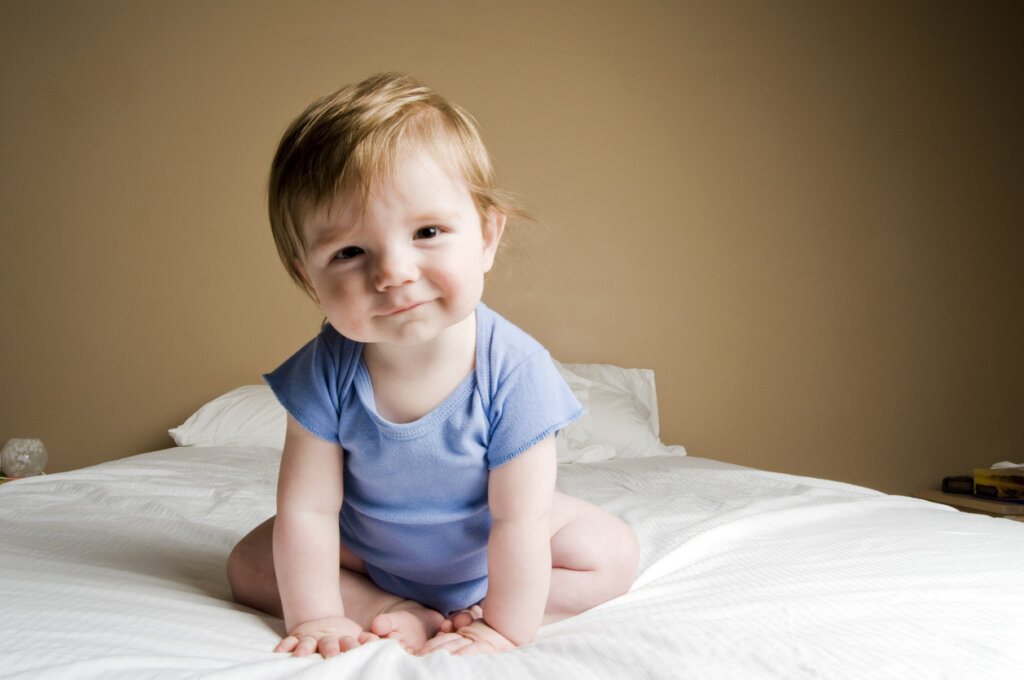Cognitive Flexibility in Babies and How to Improve It

Cognitive flexibility is a capacity that allows us to face the challenges that arise in our interaction with the environment, from birth.
For a baby, this ability represents a means of support. It signifies that they can adapt to the environment in which they were born and adjust their behavior in relation to what the situation demands of them. However, what do we know about it? Furthermore, how can we foster it in our children?
Babies and cognitive flexibility

Cognitive flexibility is the ability to move from one task to another. Also, the capacity to alter the focus of attention to face the different challenges of each one. This ability allows babies to modify certain concepts in order to deal with the problems and challenges they face in interaction with their environment.
Humans, especially babies, are extremely proficient in cognitive flexibility. Babies are particularly good at it because the behavioral and cognitive patterns that drive them to behave in certain ways haven’t yet been ingrained in their brains. Indeed, the older we become, the more we cling to our schemas and patterns of behavior.
Babies’ brains are full of connections and neurons. Nevertheless, over time, some of them will be lost, based on the experiences they have and the stimulation of their environment. This process of neuronal death is known as neuronal pruning. Thanks to this procedure, nerve cells and synapses that aren’t necessary are discarded. In fact, it allows the optimization of the functioning of the brain.
Due to the large number of synapses and neurons that babies possess, they can make use of cognitive flexibility more easily. This means they’re able to solve the problems that the environment presents to them. Indeed, this availability of neuronal connections is the basis on which babies adapt to their changing context, one that’s made up of a whole host of different meanings.
Cognitive flexibility in babies is important. It means they can develop creativity, imagination, and other mental processes. These allow them to advance cognitively and display whatever behavior is necessary to achieve certain goals or objectives.
The importance of cognitive flexibility in babies

Cognitive flexibility is important as it:
- Allows us to effectively and efficiently detect information from our environment.
- Helps us to better tolerate changes in the environment.
- Facilitates our adaptation to different vital contexts.
- Allows us to contemplate things, concepts, ideas, and problems from multiple perspectives.
- Enhances our development of resilience. We develop it by facing the obstacles and difficulties of life.
- Helps deactivate schemas and patterns for acting differently, as each individual situation demands.
- Allows us to adapt our mental activity to the demands of our environment.
- Eases our transition from one activity to another.
- Allows us to formulate goals and plan, supervise, adjust and evaluate action plans. It’s one of the executive functions.
How to promote cognitive flexibility in babies
Cognitive flexibility becomes particularly relevant in the preschool years. However, it can be stimulated from previous years. In order to promote it, keep in mind the following:
- Allow the baby to explore their environment and give them the opportunity to touch different objects. This will help them interact and become familiar with different things.
- Let them interact with the same toy in different ways.
- Stimulate their senses with different stimuli. This allows them to perceive the world from different perspectives. Don’t do it all at once though as this will overwhelm their senses.
- Include surprise or different activities in their routine so that they can develop their ability to adapt to different situations.
- Make it easy for them to interact with different toys at different times of the day.
- Read children’s stories to them. This will help them become familiar with the sounds of words. It’ll also stimulate their imagination and help them learn about the world around them.
Finally, cognitive flexibility in babies is an innate potentiality. Through it, they can adjust and develop their cognitive processes in order to adapt to the environment. It’s a facilitator of creativity and learning as it enables the baby to associate concepts from different perspectives.
All cited sources were thoroughly reviewed by our team to ensure their quality, reliability, currency, and validity. The bibliography of this article was considered reliable and of academic or scientific accuracy.
- Santaella, Maribel. (2006). La evaluación de la creatividad. SAPIENS, 7(2), 89-106. Recuperado en 11 de mayo de 2022, de http://ve.scielo.org/scielo.php?script=sci_arttext&pid=S1317-58152006000200007&lng=es&tlng=es.
- Bausela Herreras, Esperanza. (2014). Funciones ejecutivas: nociones del desarrollo desde una perspectiva neuropsicológica. Acción Psicológica, 11(1), 21-34. https://dx.doi.org/10.5944/ap.1.1.13789
- Buttelmann, F., & Karbach, J. (2017). Development and plasticity of cognitive flexibility in early and middle childhood. Frontiers in psychology, 1040.
This text is provided for informational purposes only and does not replace consultation with a professional. If in doubt, consult your specialist.








